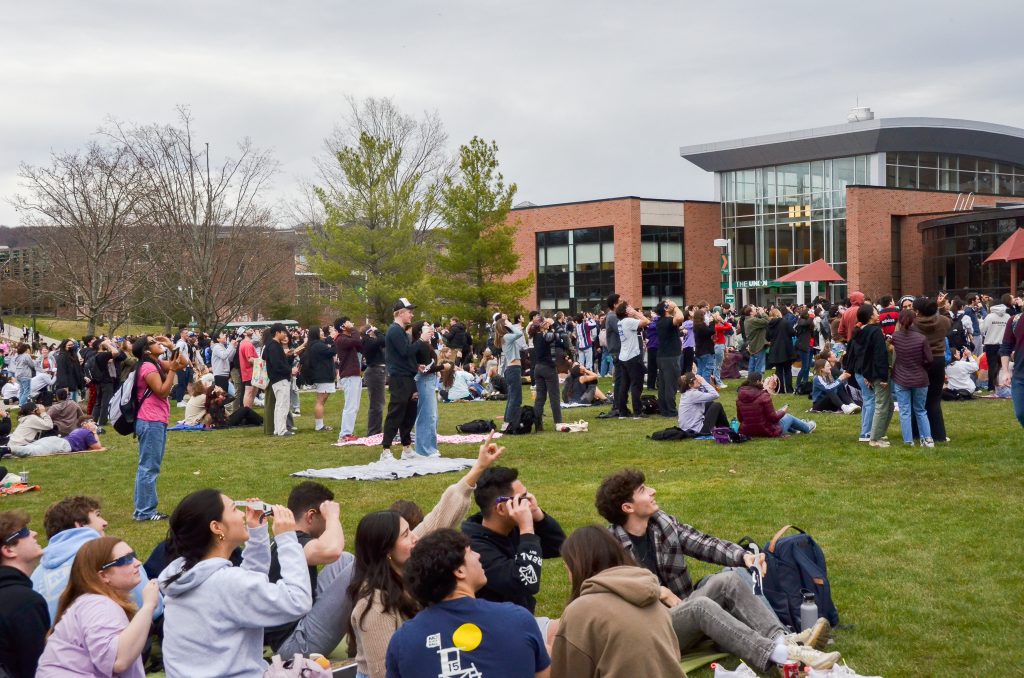Students gazed up at cloudy skies on Binghamton University’s Peace Quad on Monday in hopes of watching this year’s total solar eclipse.
The morning sky over the University was partly cloudy, with breaks in the clouds allowing for direct sun viewing. Students were excited to observe the celestial event, the first eclipse of its kind visible in the United States since 2017. Old Union Hall ran out of solar eclipse glasses soon after they began giving them out at noon, with paper signs posted on the front doors inviting students to learn more about eclipse safety. Many students obtained their glasses in advance.
“There’s a local farmer’s market in Binghamton, and my friend picked [the solar glasses] up for us,” said Daniella Deckaj, a junior majoring in integrative neuroscience. “The glasses still work even with the clouds.”
The eclipse hit landfall on Mexico’s western shore and crossed into the United States by early afternoon. Millions of people across 13 states — from Texas to Maine — found themselves directly along the line of totality, a 115-mile-wide pathway where the moon completely blocked the sun from view. While the path of totality did not directly cut through Binghamton, the city still experienced a partial eclipse with 97 percent blockage of the sun. As of last Friday, a local meteorologist predicted that Monday’s solar eclipse viewing would happen under “mostly clear’ skies.
Hours before the partial eclipse was set to begin at 2:08 p.m., some students claimed spots on campus perfect for clear skygazing. Midas Leung, a junior majoring in physics, set up two different viewing devices on the Spine. A refractor telescope with a 660 millimeter lens and a camera attached with a long lens were set up to capture close-up eclipse imaging. Even when viewing the sun through a telescope lens, Leung made sure that appropriate solar filters were used.
“We have a solar filter, it is [made of] the same stuff that is used in the glasses you wear, but it’s bigger,” Leung said. “I bought the filter, but I had to make the [cardboard square] to actually attach it on.”
As the clock approached the 2:00 p.m. hour, students began to gather around the Peace Quad to watch the eclipse begin. Many brought picnic blankets and laid them around the grass field to sit on with friends. The chemistry department also hosted an organized viewing group at Science II for students and faculty to view the astronomical event.
As the sky turned dark gray at 2:30, a wave of suspense filled the air. Many students struggled to view the sun — with or without glasses — behind the thick wall of rain clouds. The gray atmosphere burst into excitement at 3:00 when the clouds briefly cleared to reveal the outline of a darkened sun, which disappeared within minutes.
At 3:23, the eclipse reached its peak across the University. While the sky grew noticeably darker and the temperature cooled, students remained unable to view the eclipse. The sky slowly lit up again within a few minutes, signaling the moon’s retreat. Students began to leave the Peace Quad, having been robbed of the chance to view a rare celestial phenomenon. The next total eclipse to pass through New York state will not be until 2079. Despite this, students on campus were still excited about being part of a community experience.
“While it is a little bit cloudy, I am mostly excited about the fact that this has been a community event,” said Rachel Pasternack, a sophomore majoring in history. “It’s really nice seeing everyone out and about.”
Many students traveled instead of remaining on campus, opting to venture north to a town or city that fell within the line of totality. Buffalo and Oswego were popular cities for those hoping to experience the twilight darkness and glowing halo from a fully obscured sun. Like in Binghamton, clouds blanketed the sky even miles up north.
“I visited a friend in Buffalo, and although the overcast weather was a little disappointing, being right in the line of totality meant that we had almost [four] minutes of darkness,” Alexander Cass, a senior majoring in computer science, wrote. “It was really cool to witness this cosmic event, and I think it was worth the drive.”



